Mushroom Biryani is a flavorful delight recipe! First, fluffy basmati rice meets savory mushrooms and aromatic spices, creating a perfect harmony of flavors. Whether it's a special occasion or a casual meal, this dish will please both biryani lovers and mushroom fans. Let’s cook up some magic with this Mushroom Biryani Recipe!

Jump to:
- About Mushroom Biryani Recipe
- What is Mushroom Biryani?
- Mushroom Types
- Health Benefits of Mushrooms
- What You Need for Mushroom Biryani?
- How to Make Mushroom Biryani
- Creative Twists: Unique Variations of Mushroom Biryani
- What to Serve with Mushroom Biryani
- Tips and Tricks for Perfect Mushroom Biryani
- Creative Leftover Ideas
- ❔FAQs
About Mushroom Biryani Recipe
Biryani’s Rich History: Biryani, believed to be brought to India by the Mughals, has a rich and flavorful history! Over time, it evolved into different regional styles like Hyderabadi, Lucknowi, and Kolkata biryani, each with its own unique twist.
Regional Variations: Mushroom Biryani is a perfect recipe example of this delicious diversity! Whether it’s in Hyderabadi, Kolkata, or South Indian style, the spices and cooking methods give each version its own special taste.
Biryani in Everyday Life: Biryani is more than just food—it’s a comfort food for celebrations, festivals, and family get-togethers. Mushroom Biryani can easily become a vegetarian favorite, loved by everyone!
What is Mushroom Biryani?
Mushroom Biryani is a delicious vegetarian recipe version of the traditional biryani, where juicy mushrooms replace meat. Not only does it maintain the rich, aromatic flavors of biryani, but it also adds a unique umami twist, making it both satisfying and flavorful!
Why is Mushroom Biryani Special?
The mushrooms bring an earthy flavor and meaty texture to the dish, making it the perfect meat substitute. Moreover, they are low in calories, high in fiber, and packed with vitamins, making Mushroom Biryani recipe a healthy and tasty option!
Why Choose Mushroom Biryani?
Whether you're a vegetarian or just want to try something new, Mushroom Biryani recipe is a great choice! 🍽️ It’s perfect for anyone craving the classic biryani experience, without the meat, and adds a refreshing plant-based twist to your meal!
Mushroom Types
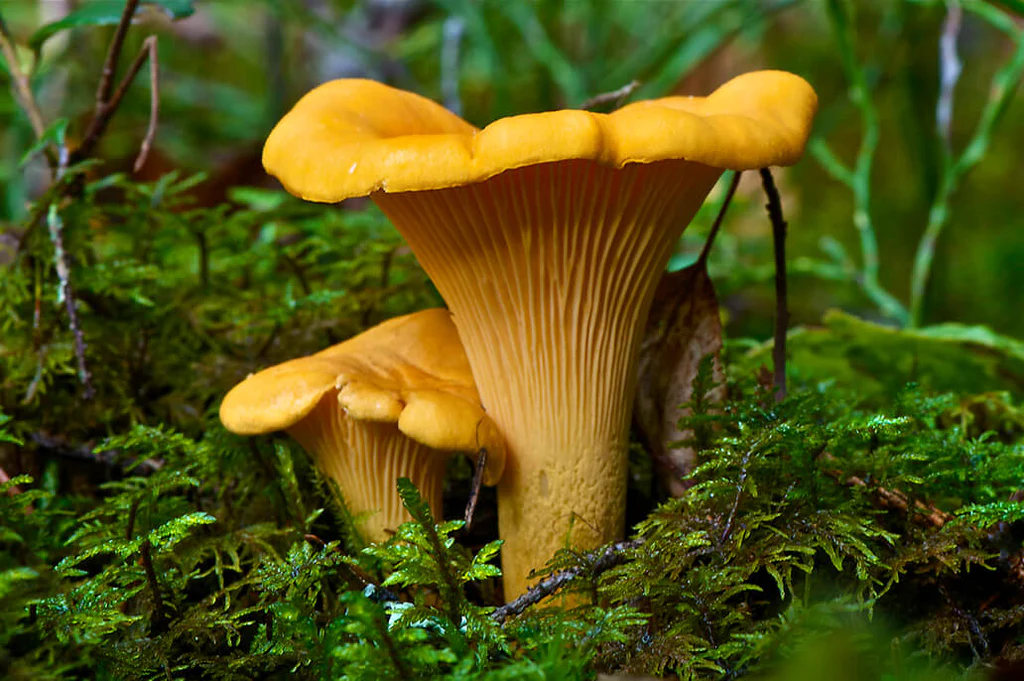
1. Chanterelle Mushrooms: Finally, chanterelle mushrooms are known for their golden color and fruity aroma. They’re a gourmet variety that adds a luxurious touch to dishes like risotto or sautéed vegetables.
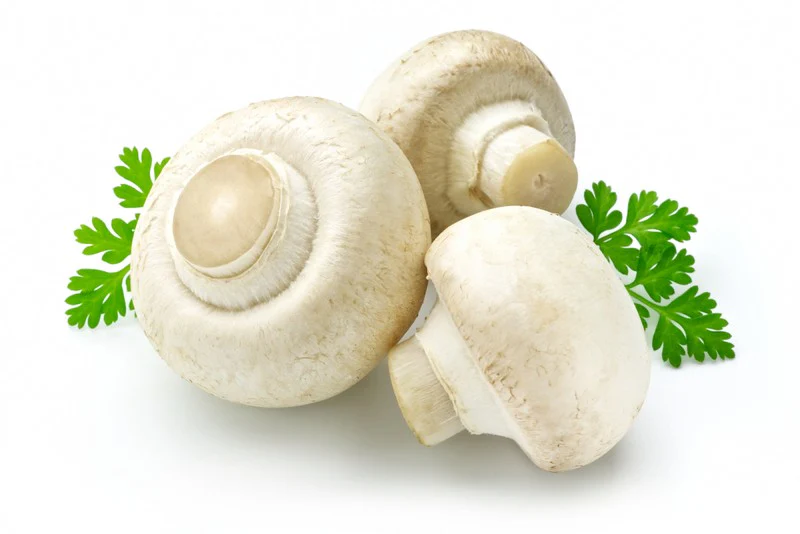
2. Button Mushrooms: To begin with, button mushrooms are the most common type and are widely used in various dishes. These small, white mushrooms have a mild flavor and tender texture, making them perfect for soups, stir-fries, and salads.
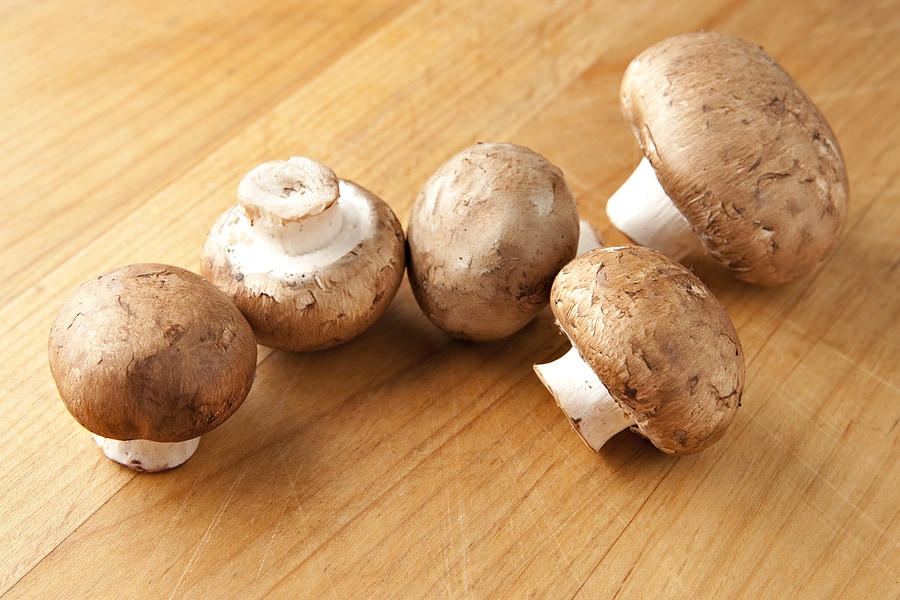
3. Cremini Mushrooms: In addition, cremini mushrooms are similar to button mushrooms but with a deeper, earthier flavor. They’re perfect for adding a rich taste to sauces, pasta, or risottos.
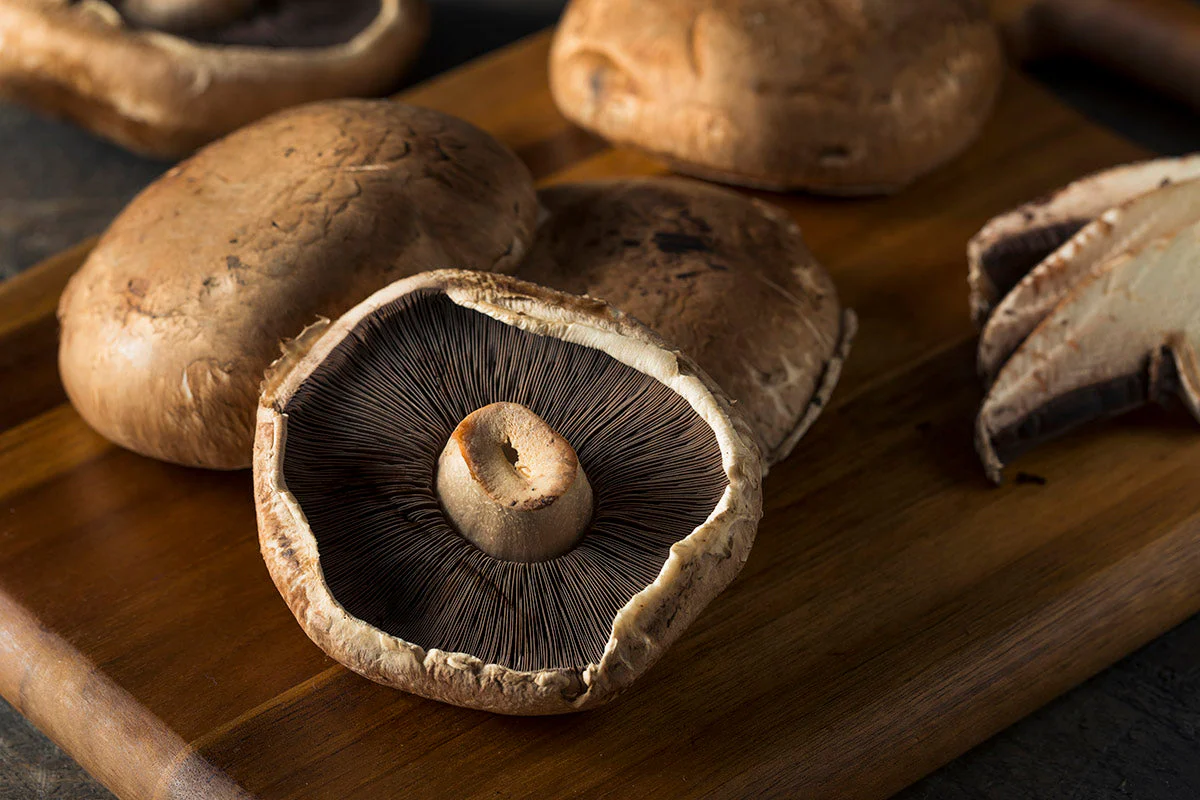
4. Portobello Mushrooms: Moreover, portobello mushrooms are the large, meaty variety known for their robust flavor. Because of their size, they make excellent substitutes for meat in burgers or grilled dishes.
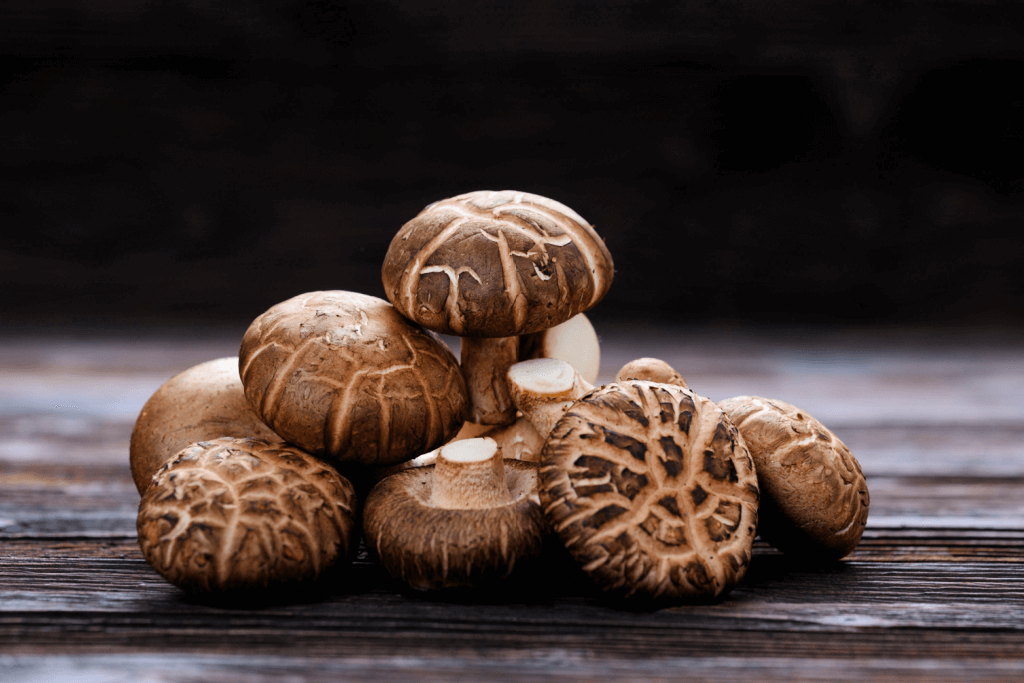
5. Shiitake Mushrooms: Furthermore, shiitake mushrooms are known for their rich umami flavor and chewy texture. These mushrooms are often used in Asian cuisine, particularly in stir-fries, soups, and ramen.
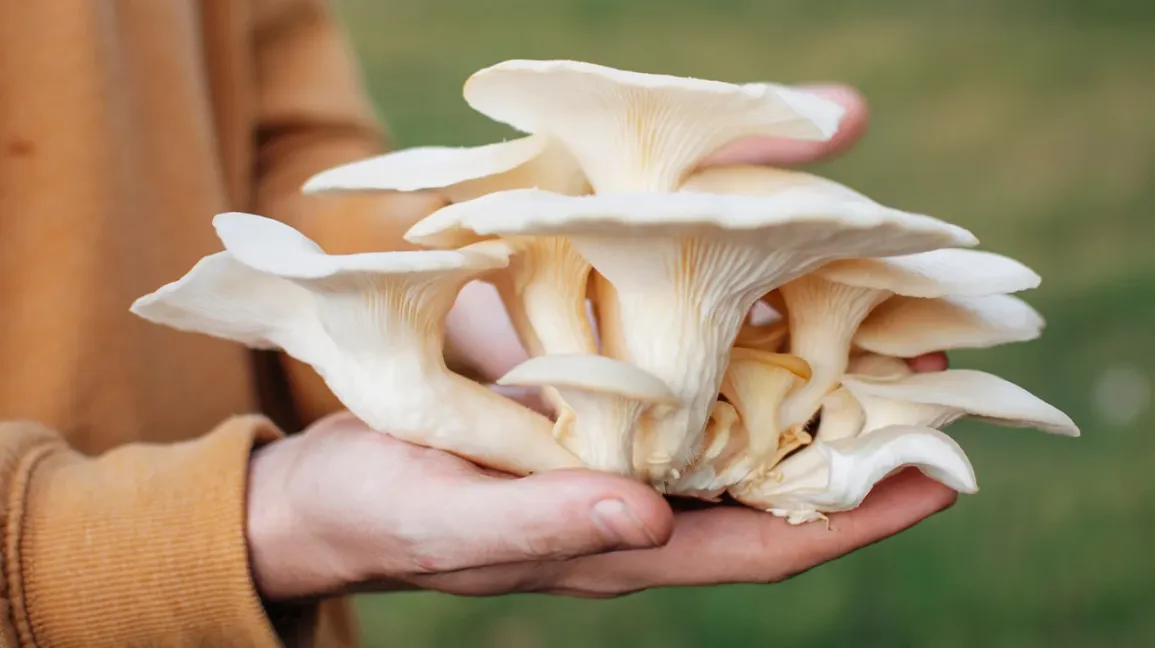
6. Oyster Mushrooms: Additionally, oyster mushrooms have a delicate texture and slightly sweet flavor. They’re often used in stir-fries, sauces, or as a topping for pizzas.

Health Benefits of Mushrooms
- Blood Sugar Control 🍬: Mushrooms may help regulate blood sugar, making them ideal for diabetics.
- Nutrient-Rich: Mushrooms are packed with essential vitamins, minerals, and antioxidants, promoting overall well-being.
- Immune Boost: Thanks to their antioxidants, mushrooms strengthen the immune system, helping fight off infections.
- Low-Calorie Option: With fewer calories, mushrooms are perfect for those looking to maintain a healthy weight.
- Digestive Health: High in fiber, mushrooms support digestion and gut health.
- Heart Health: Potassium-rich mushrooms help regulate blood pressure, benefiting your heart.
- Antioxidant Power: Their antioxidants protect cells from damage and reduce inflammation.
- Bone Health: Mushrooms are a rare plant-based source of vitamin D, supporting strong bones.
Explore More Delicious Recipes!
- Veggie Biryani – A fragrant, veggie-packed delight!
- Egg Biryani – For the egg lovers, a perfect blend of spice and flavor!
- Mutton Biryani – Tender, flavorful mutton cooked to perfection!
- Prawn Biryani – A seafood twist that'll leave you craving for more!
- Paneer Lababdar – Creamy, rich, and full of flavor – a paneer lover’s dream!
What You Need for Mushroom Biryani?
Key Ingredients:
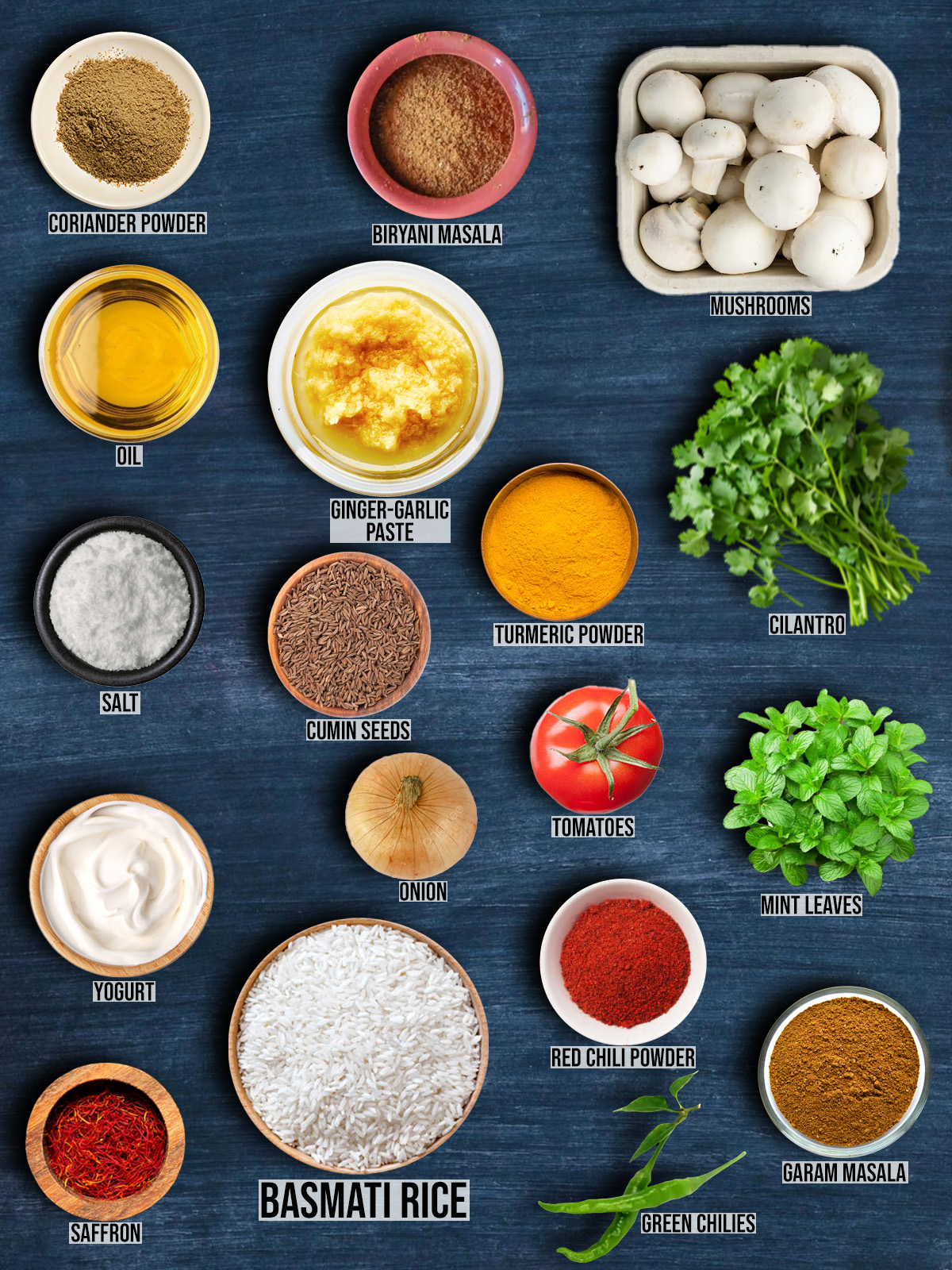
Ingredients Breakdown:
- Mushrooms: You can use button, shiitake, or portobello mushrooms. Each brings its unique texture and umami flavor, making the biryani more delicious.
- Rice: Basmati rice is ideal due to its long grains and fragrant aroma. For a twist, try saffron rice or herb-infused rice for added depth.
- Aromatic Spices:
- Whole Spices: Cinnamon sticks, cardamom, cloves, bay leaves, and star anise add fragrance.
- Ground Spices: Garam masala, coriander, cumin, turmeric, and red chili powder give warmth and flavor.
- Saffron: A few strands soaked in warm milk for a beautiful color and aroma.
- Vegetables & Herbs: Fried onions (Birista) add richness, while fresh coriander, mint, and tomatoes offer freshness. Ginger-garlic paste boosts the flavor.
- Yogurt & Cream: Essential for a smooth, creamy gravy. Alternatively, coconut milk or cashew paste can create a richer texture.
3 Ways Cooking Techniques
1️⃣ Stovetop Method
- Firstly, sauté onions, garlic, and spices in a large pot until fragrant.
- Next, add the mushrooms and cook until they’re soft and tender.
- Then, add rice and water. Bring it to a boil, reduce the heat, and cover. In no time, the rice will be fluffy and ready.
2️⃣ Pressure Cooking
- To begin with, sauté the aromatics as usual.
- After that, add rice and water, then close the lid.
- Once the lid is sealed, cook on high pressure for 5-7 minutes. Finally, let it release naturally for a perfect texture.
3️⃣ Slow Cooking
- First, layer your ingredients in the slow cooker.
- Then, add the rice and water.
- Cover and let it cook on low for 3-4 hours. This method allows the flavors to blend beautifully, creating a rich and aromatic biryani.
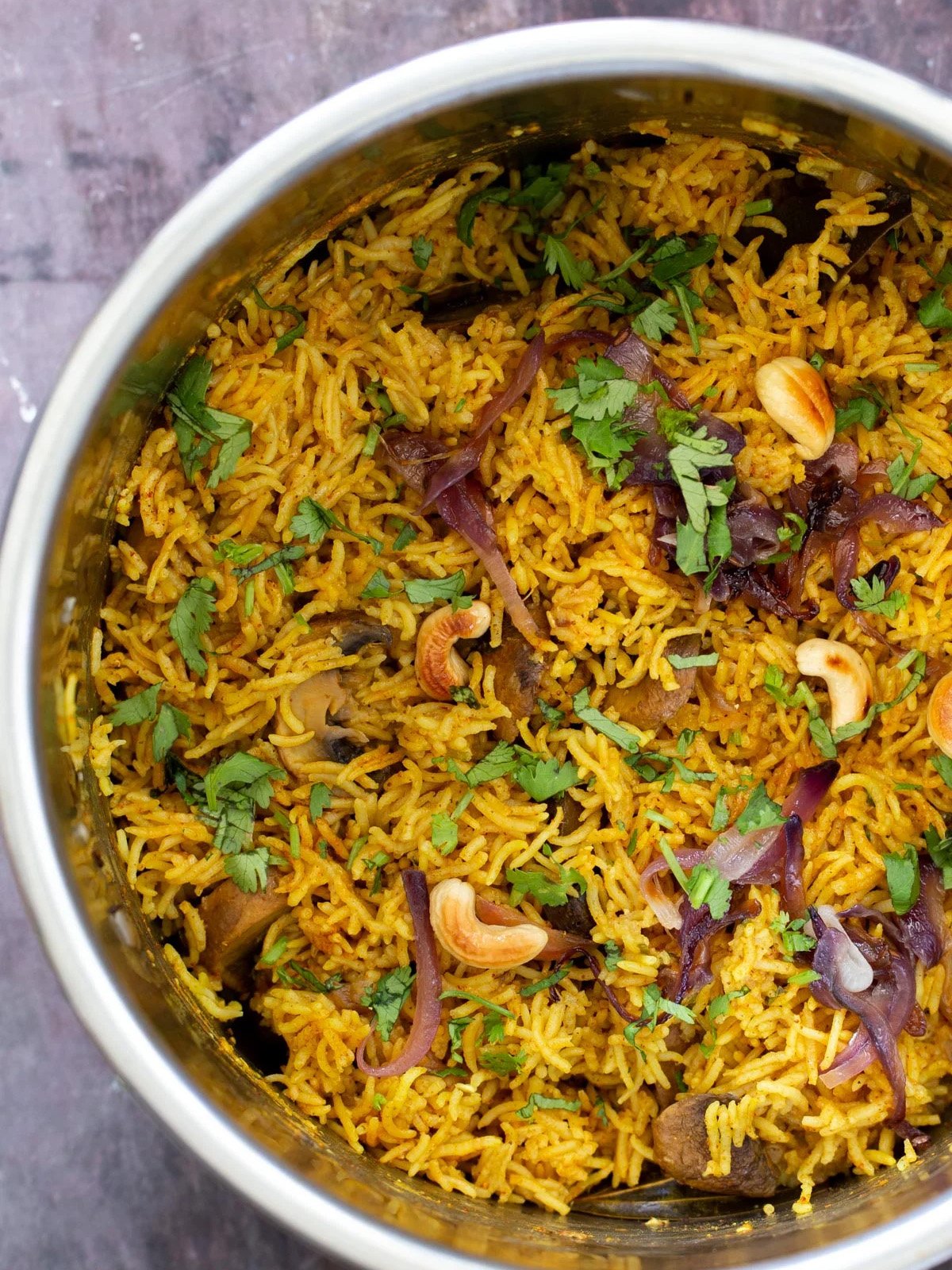
How to Make Mushroom Biryani
Step by Step Instructions- Mushroom Biryani Recipe
1: Preparing the Rice
- First, wash and soak basmati rice for at least 30 minutes. This ensures fluffy, non-sticky grains.
- Next, cook the rice to 90% done (parboiled). The key is to avoid overcooking, as it helps in layering without turning mushy.
2: Preparing the Mushroom Masala
- Firstly, temper whole spices, then sauté onions, ginger-garlic paste, and mushrooms.
- After that, add tomatoes and let the mushrooms release moisture, absorbing the spices in the process. This makes the masala flavorful and aromatic.
3: Layering the Biryani
- Once the mushroom masala is cooked, layer it with the parboiled rice in a sealed pot (using the traditional dum method).
- This method gives the biryani its signature texture and flavor as the layers infuse together.
4: Cooking the Biryani (Dum)
- At this point, cook the biryani on low heat to allow all the flavors to blend.
- To seal, use dough or a heavy lid to trap the steam, ensuring even cooking and a rich aroma.
5: Garnishing
- Finally, garnish with fried onions, mint, coriander leaves, and saffron milk.
- This step not only enhances the flavor but also adds a vibrant touch to the dish.
Creative Twists: Unique Variations of Mushroom Biryani
1. Mushroom & Paneer Biryani
- Not only does this variation add cubes of paneer, but it also introduces extra protein and richness to the dish.
- Especially for vegetarian biryani lovers, this option provides a richer texture that elevates the flavor.
2. Mushroom & Vegetable Biryani
- In addition to the mushrooms, you can incorporate a variety of colorful vegetables like carrots, peas, green beans, and potatoes.
- As a result, the dish becomes more nutritious and visually appealing, adding both flavor and health benefits.
3. Coconut Mushroom Biryani
- Furthermore, adding coconut milk or grated coconut gives the biryani a subtle sweetness and creamy texture.
- This variation is great because the coconut flavor enhances the earthiness of the mushrooms, making each bite more delicious.
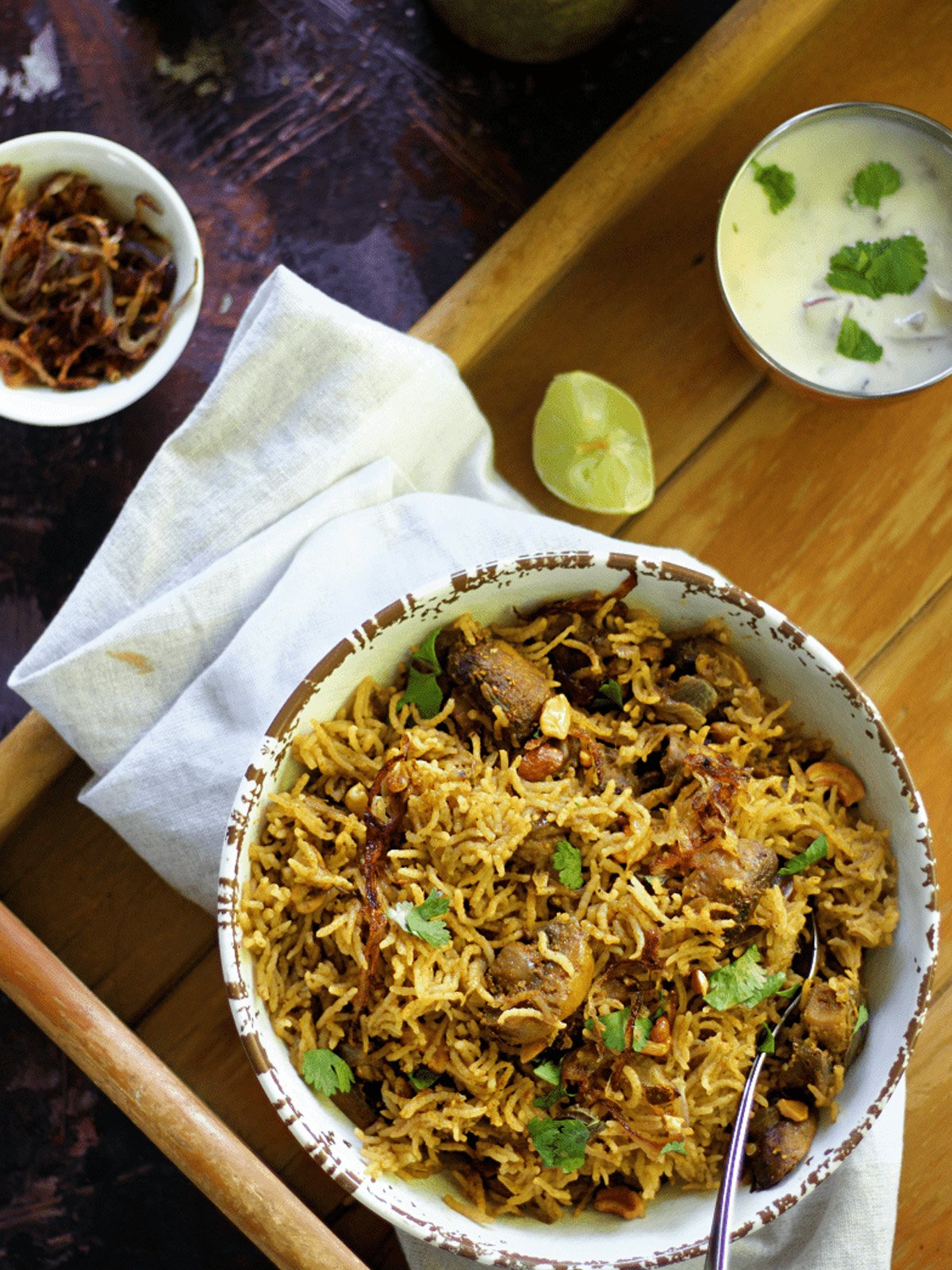
4. Spicy Mushroom Biryani
- For those who enjoy a little more heat, you can add extra green chilies, black pepper, or cayenne.
- Consequently, the biryani gains a spicy kick, making it perfect for those who love bold, fiery flavors.
5. Mushroom Pulao
- If you are looking for a quicker version, then try making a Mushroom Pulao by sautéing mushrooms and spices and mixing them with pre-cooked rice.
- Afterward, the result is a flavorful, easy-to-make dish that skips the layering process but still delivers great taste.
What to Serve with Mushroom Biryani
- Dal Tadka: Finally, a warm bowl of dal (lentil curry) complements the biryani and makes the meal even more filling. Given that dal is rich and hearty, it pairs perfectly with the spices in the biryani.
- Raita: To begin with, a cool and creamy yogurt raita (boondi, cucumber, or onion) perfectly balances the spicy flavors of the biryani. Not only does it provide a refreshing contrast, but it also helps tone down the heat.
- Pickles: Moreover, serve it with tangy mango or lime pickle for that extra zing. This combination brings a spicy, tart kick that pairs beautifully with the richness of the biryani.
- Salads: In addition, a simple kachumber salad (cucumber, tomatoes, onions) adds a fresh crunch and tanginess, enhancing the biryani's flavor. For example, the crunch of fresh veggies cuts through the richness and offers a light balance.
- Papad: Furthermore, crispy papads provide a delightful texture contrast. This extra crunch adds a fun element to each bite of the biryani. 🍽️
Tips and Tricks for Perfect Mushroom Biryani
1. Use Ghee for Extra Flavor: Although you can use oil, ghee (clarified butter) adds an irresistible richness and nutty flavor to the biryani, making it more authentic and flavorful.
2. Choosing the Right Mushrooms: To start, button mushrooms are the most commonly used in biryani, but feel free to experiment with shiitake, portobello, or even oyster mushrooms. Each variety offers a unique texture and flavor, elevating the dish in different ways.
3. Don’t Overcook the Mushrooms: It’s important to note that mushrooms release water when cooked. Therefore, be careful not to overcook them, as this can make the biryani soggy. Cook them just right to keep the texture firm and delicious.
4. Soak the Rice: Moreover, always soak basmati rice for at least 30 minutes before cooking. This step helps the rice remain fluffy and separate, making your biryani light and perfect.
5. Avoid Overmixing: After cooking, let the biryani rest for a few minutes. This way, the flavors settle, and when you fluff the rice with a fork, it maintains its delicate texture without becoming mushy.
Creative Leftover Ideas
- With Rice: First and foremost, leftover rice can be transformed into a delicious fried rice. Simply toss it in a hot pan with some vegetables, soy sauce, and a scrambled egg for a quick and tasty meal.
- With Vegetables: Moreover, leftover cooked vegetables can be used in a hearty vegetable soup or stew. For instance, you can blend them into a creamy puree for a comforting soup, or add them to a casserole.
- With Meat: In addition, leftover cooked meat can be turned into a savory sandwich or wrap. Whether it's chicken, beef, or lamb, simply add some fresh veggies, cheese, and a tasty sauce for a quick and satisfying lunch.
- With Pasta: Another idea is to use leftover pasta in a pasta bake. Simply mix it with some sauce, cheese, and your choice of vegetables or protein, and bake until golden and bubbly.
- With Bread: Additionally, leftover bread can be repurposed into breadcrumbs for coating dishes like chicken or fish. Alternatively, you can make a simple bread pudding for a sweet treat!
- With Fruit: Finally, leftover fruit can be used to make a refreshing fruit salad, smoothie, or even a fruity dessert like a crumble or pie.
Did you try this Mushroom Biryani recipe? Leave a ⭐️⭐️⭐️⭐️⭐️ rating below and share it on Instagram, Facebook, and Pinterest!
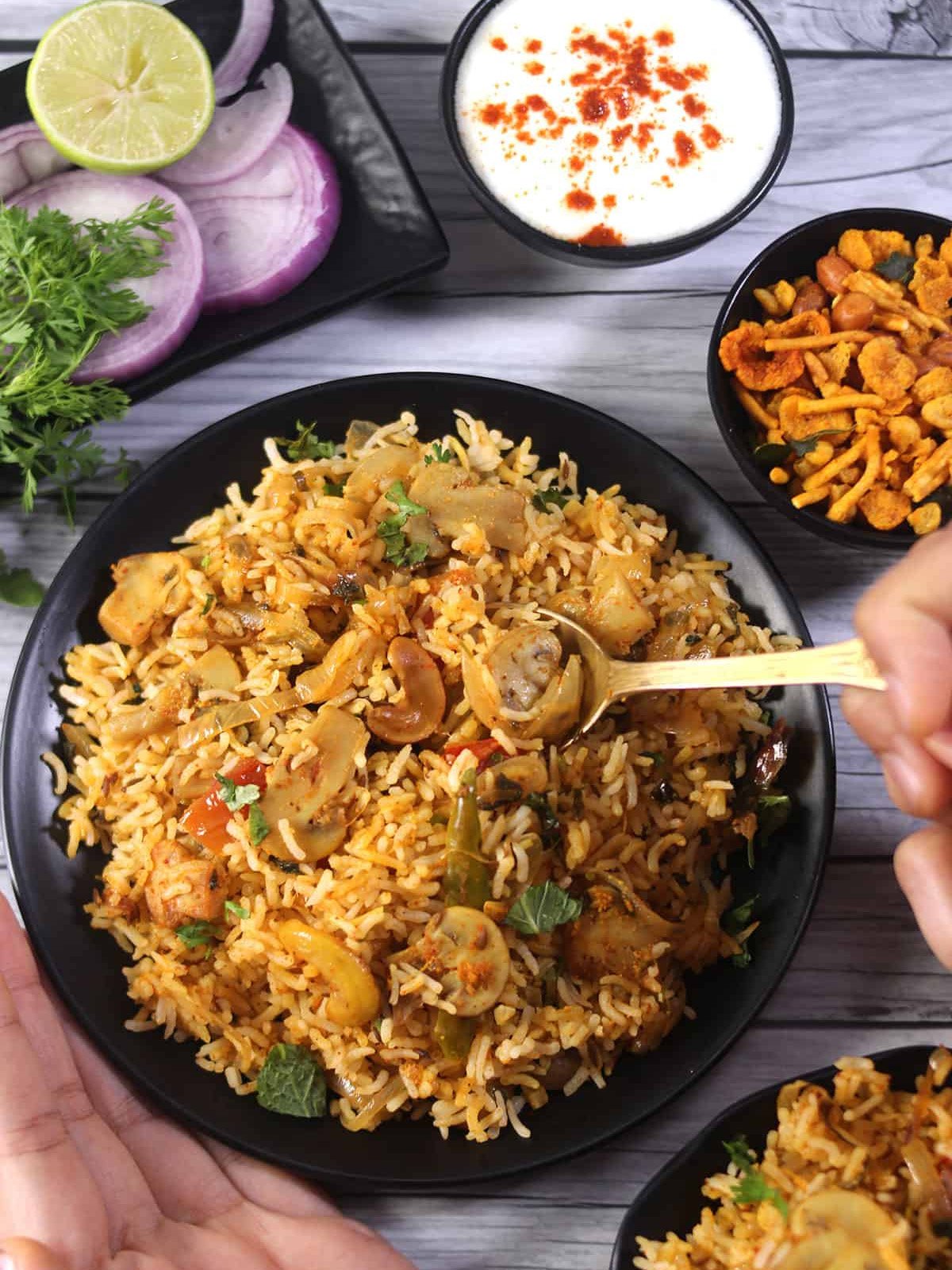
❔FAQs
Discover what Mushroom Biryani is, its ingredients, and how it differs from traditional biryani.
Find detailed steps and tips on how to prepare Mushroom Biryani, including cooking techniques and ingredient recommendations.
Learn how to adapt Mushroom Biryani to be vegan-friendly by substituting dairy products and using plant-based alternatives.
Get tips on maintaining the perfect rice texture and avoiding common pitfalls when making Mushroom Biryani.
Understand the implications of using frozen mushrooms versus fresh ones in Mushroom Biryani.
Find advice on how to properly store Mushroom Biryani and the best methods for reheating it without losing flavor or texture.
Get recommendations for side dishes and accompaniments that complement the flavors of Mushroom Biryani.
Learn about the total cooking time required for making Mushroom Biryani, including preparation and cooking phases.
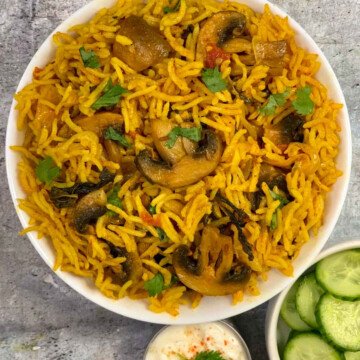
Mushroom Biryani Recipe
Ingredients
For the Biryani:
- 1 ½ Cup Basmati rice
- 2 Cup Mushrooms, sliced
- 1 Large onion, thinly sliced
- 2 Tomatoes, chopped
- 1 Cup Plain yogurt
- 2 tablespoon Ginger-garlic paste
- 2-3 Green chilies, slit
- 1 teaspoon Cumin seeds
- 1 teaspoon Coriander powder
- 1 teaspoon Garam masala
- ½ teaspoon Turmeric powder
- ½ teaspoon Red chili powder
- 1 tablespoon Biryani masala (optional)
- ¼ Cup Fresh cilantro, chopped
- ¼ Cup Fresh mint leaves, chopped
- 3 tablespoon Cooking oil or ghee
- 2 Cup Water
- 1-2 tablespoon Saffron strands soaked in 2tbsp warm milk (optional)
- Salt to taste
For Garnishing:
- Fried onions
- Fresh cilantro and mint leaves
Instructions
Preparing the Rice
- First, wash and soak basmati rice for at least 30 minutes. This ensures fluffy, non-sticky grains.
- Next, cook the rice to 90% done (parboiled). The key is to avoid overcooking, as it helps in layering without turning mushy.
Preparing the Mushroom Masala
- Firstly, temper whole spices, then sauté onions, ginger-garlic paste, and mushrooms.
- After that, add tomatoes and let the mushrooms release moisture, absorbing the spices in the process. This makes the masala flavorful and aromatic.
Layering the Biryani
- Once the mushroom masala is cooked, layer it with the parboiled rice in a sealed pot (using the traditional dum method).
- This method gives the biryani its signature texture and flavor as the layers infuse together.
Cooking the Biryani (Dum)
- At this point, cook the biryani on low heat to allow all the flavors to blend.
- To seal, use dough or a heavy lid to trap the steam, ensuring even cooking and a rich aroma.
Garnishing
- Finally, garnish with fried onions, mint, coriander leaves, and saffron milk.
- This step not only enhances the flavor but also adds a vibrant touch to the dish.
Notes
Creative Twists: Unique Variations of Mushroom Biryani
1. Mushroom & Paneer Biryani-
- Not only does this variation add cubes of paneer, but it also introduces extra protein and richness to the dish.
-
- Especially for vegetarian biryani lovers, this option provides a richer texture that elevates the flavor.
-
- In addition to the mushrooms, you can incorporate a variety of colorful vegetables like carrots, peas, green beans, and potatoes.
-
- As a result, the dish becomes more nutritious and visually appealing, adding both flavor and health benefits.
-
- Furthermore, adding coconut milk or grated coconut gives the biryani a subtle sweetness and creamy texture.
-
- This variation is great because the coconut flavor enhances the earthiness of the mushrooms, making each bite more delicious.
-
- For those who enjoy a little more heat, you can add extra green chilies, black pepper, or cayenne.
-
- Consequently, the biryani gains a spicy kick, making it perfect for those who love bold, fiery flavors.
-
- If you are looking for a quicker version, then try making a Mushroom Pulao by sautéing mushrooms and spices and mixing them with pre-cooked rice.
-
- Afterward, the result is a flavorful, easy-to-make dish that skips the layering process but still delivers great taste.






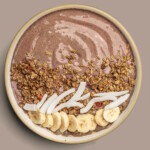






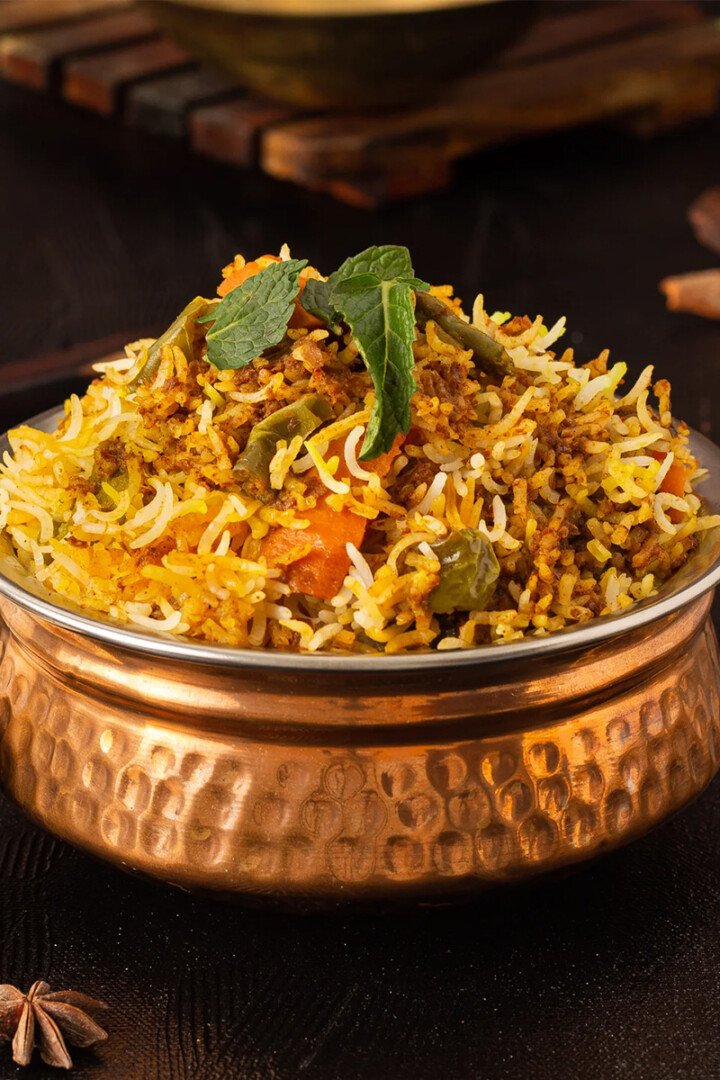
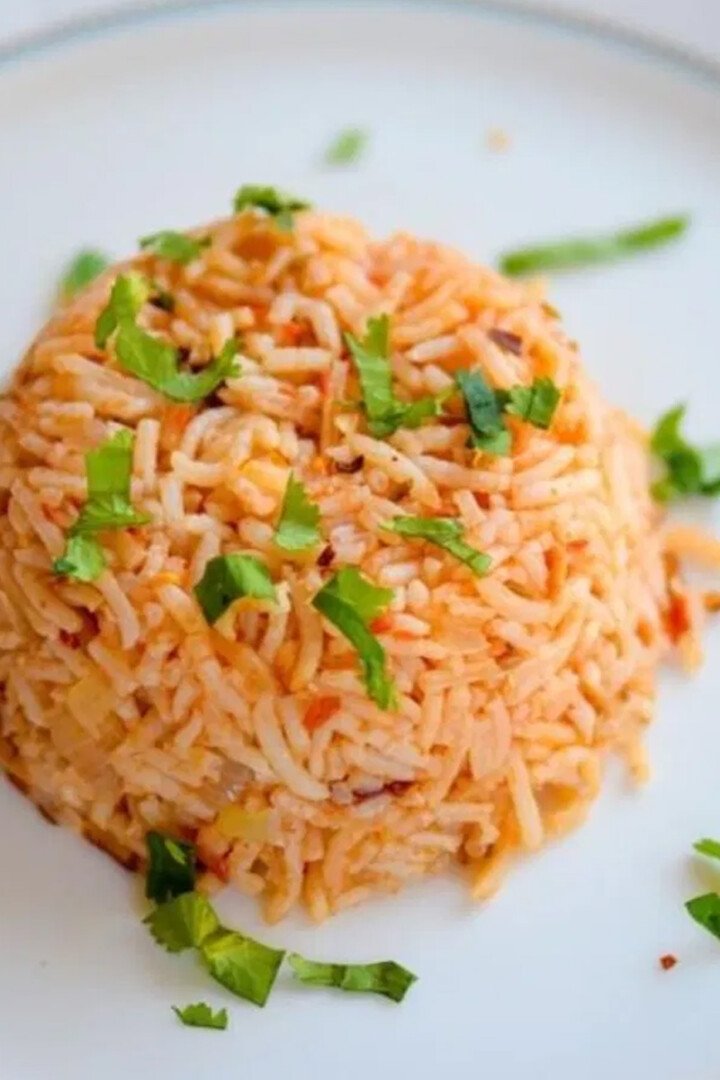
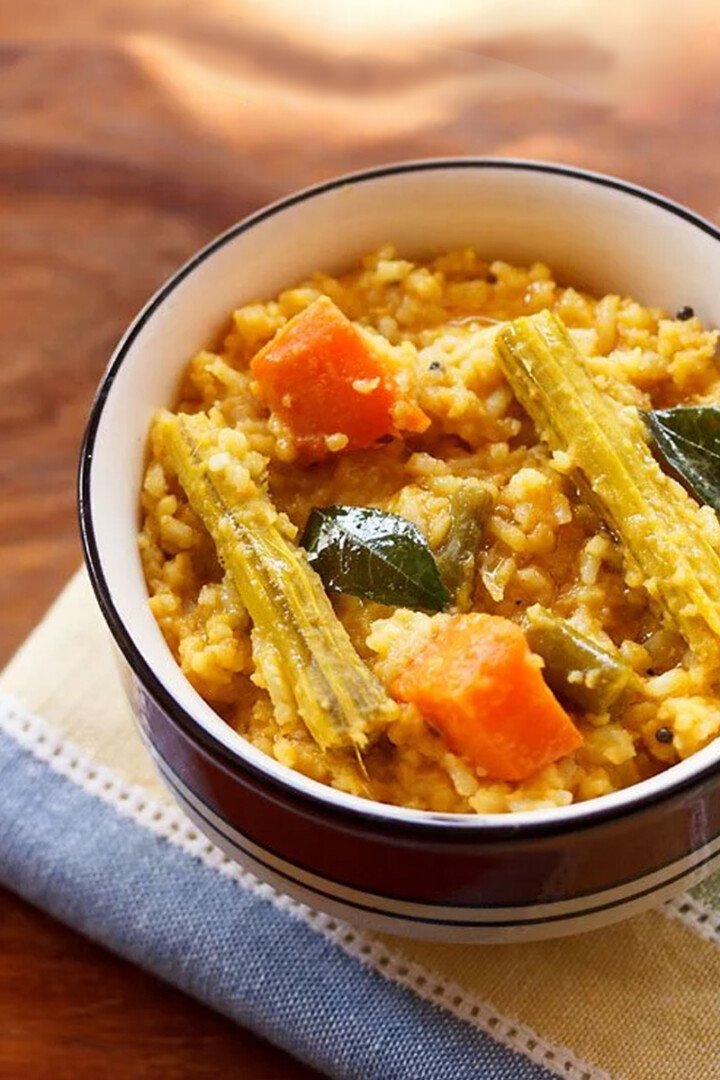
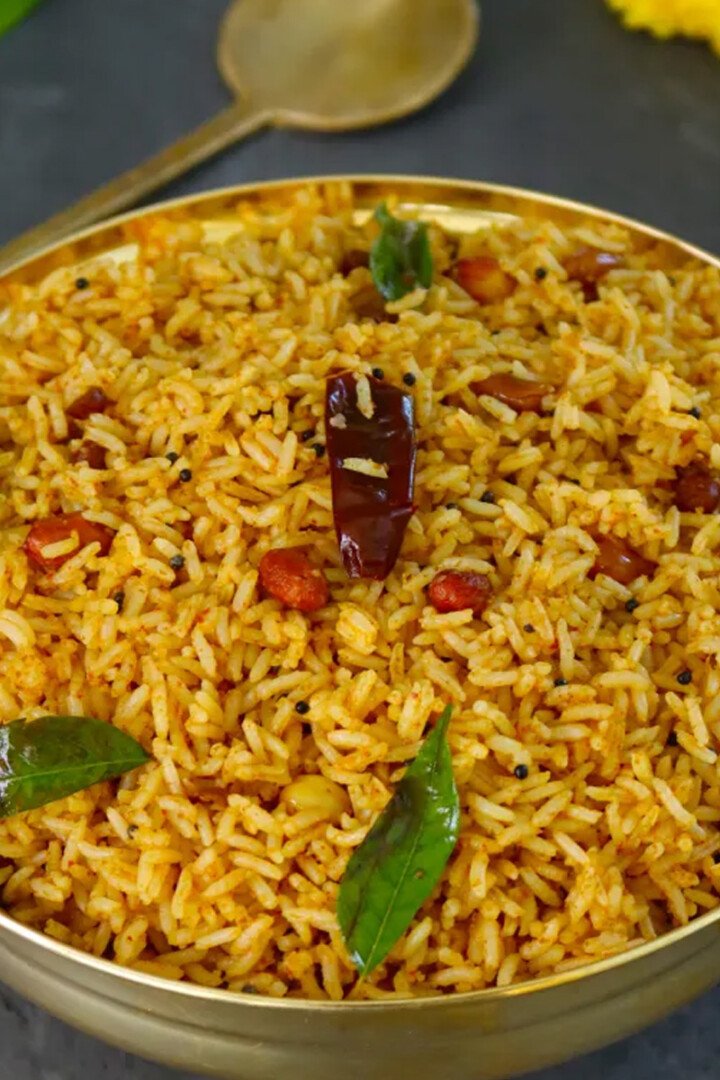
Leave a Reply